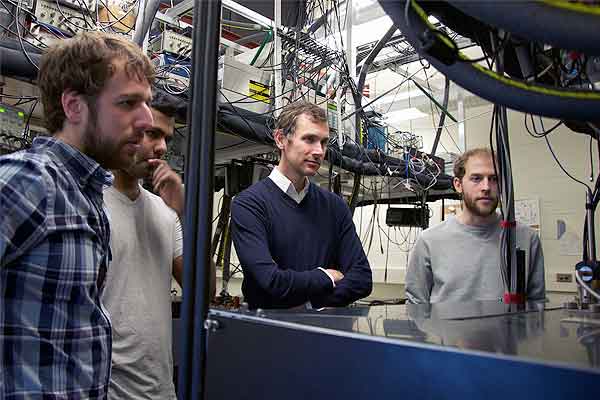
U of T physicists taking a cold look at atomic interactions
Published: February 22, 2016
Researchers led by Joseph Thywissen of the University of Toronto’s department of physics have discovered new rules governing the behaviour of atoms that collide at temperatures close to absolute zero.
By adjusting the magnetic field surrounding these atoms and making observations through a process called dynamical spectroscopy, the researchers were able to measure correlations and find evidence for the laws governing p-wave interactions, which are rare in nature. The result could be new insights into superconductivity, superfluidity and other fundamental properties of materials.
The research appears in a paper published on Feb. 22 in the journal Nature Physics.
“Ultracold atoms are the stem cells of materials science,” says Thywissen, a professor of physics and fellow of the quantum materials program at the Canadian Institute for Advanced Research.
“Just as a stem cell can become a fingernail or a heart cell depending on its context, ultracold atoms can become metals, insulators, superfluids or other types of materials.”
In collaboration with theorists Shizhong Zhang of Hong Kong University and Zhenhua Yu of Tsinghua University, the Toronto scholars have been studying p-wave interactions in a highly controlled environment, coaxing a few hundred thousand gas atoms into a “trap,” and cooling them close to absolute zero (-273.15 Celsius).
If two atoms hit head-on and bounce straight back from one another, they have no angular momentum. This interaction is called an s-wave. But if a pair of atoms ricochet off one another with a single unit of angular momentum, the resulting interaction is known as a p-wave.
P-waves, s-waves and other types of atom-pair interactions correlate with many types of emergent physical properties. Some rules that govern these relationships are well understood, but those related to p-waves have traditionally defied explanation.
“P-wave interactions fascinate scientists because they endow materials with unusual properties and puzzling behaviours,” says Thywissen. “But the conventional wisdom was that gases with p-wave interactions had losses that were too strong to allow you see anything interesting.”
Thywissen’s team employed dynamical spectroscopy to prepare and probe atoms faster than had been done in the past.
“Our observations took less than a millisecond,” he says. “Previous studies were searching for properties that required longer observation. It allowed us to see something before the losses became too significant.”
Their orthodoxy-challenging experiments resulted more from serendipity than a conviction that there was a problem with conventional wisdom.
“We ended up looking at this because a graduate student working in our lab didn’t know how to avoid the p-wave resonances,” Thywissen says. “He took spectroscopy data on them. Nature surprised us. There was a beautiful spectroscopic signal of a new kind of pressure that was due to p-wave interactions.”
Their subsequent observations sparked a flurry of activity among theoretical physicists, resulting in several papers that attempted to explain this pressure. If correct, this theoretical work provides a new set of guidelines outlining how to understand any state of matter that emerges from p-wave interactions.
This work can help scientists better understand the fundamental question of where material properties come from. It can also make it possible to create and work with new materials that have highly unusual – and potentially very valuable – properties.
P-waves, for instance, correlate with unusual forms of superconductivity and superfluidity, in which particles flow without resistance. Such materials have vexed scientists for years.
“When made up of p-wave pairs, superconductors and superfluids should also have something called an edge current – but we know from observation that these edge currents are absent or extremely weak,” says Thywissen. “We don’t understand this. We hope the new relations we’ve discovered will help us figure out why.”
Thywissen and his collaborators are already designing new experiments designed to tune and tweak the environment, creating an even more sophisticated understanding of how material properties emerge.
“Even though this experiment looks complex now, we will continue to work to push the limits of what can be done in the lab,” Thywissen says. “We never know what we’re going to find, but we always have hope of discovering something like this. It is truly thrilling.”
Research was carried out at U of T by PhD candidates Christopher Luciuk and Scott Smale, and postdoctoral fellow Stefan Trotzky, in addition to Yu, Zhang and Thywissen.



